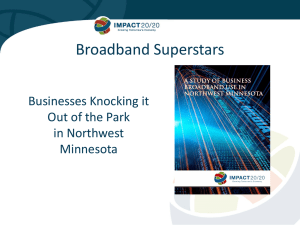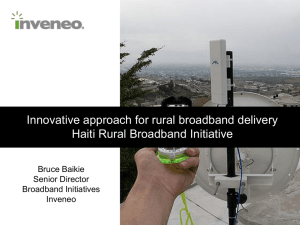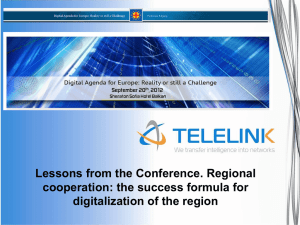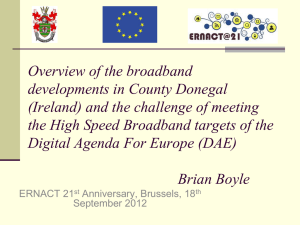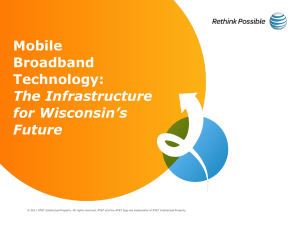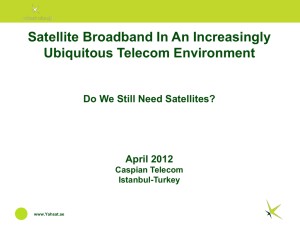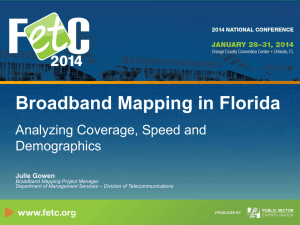The State of ICT Network Connectivity (Sami - E
advertisement
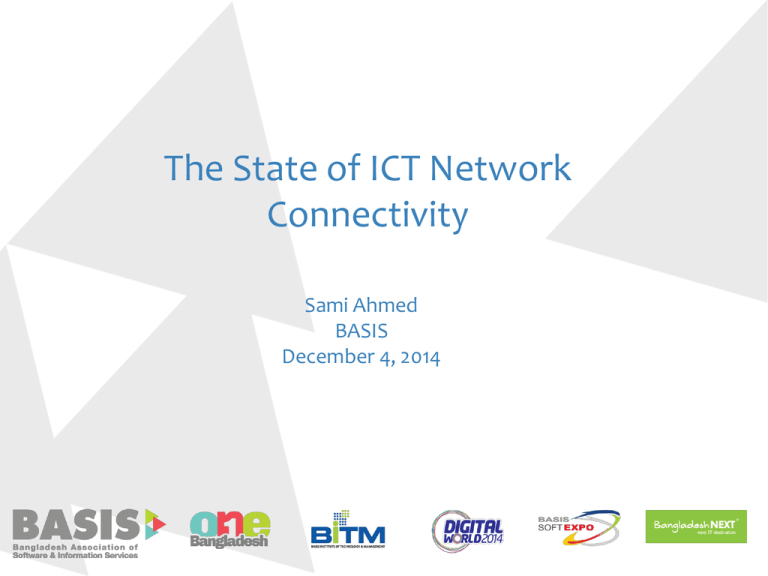
The State of ICT Network Connectivity Sami Ahmed BASIS December 4, 2014 Infrastructure and Connectivity • Power Supply – Increased by 100% in the last 5 years • Nationwide Network – 3g/4g; • Bangladesh Connects to SEAMEWE4 and soon to SEAMEWE5 • Cost of Devices have gone down • Cost of bandwidth – Tk. 2800/Mbps • Bangabandhu Satellite expected to launch by 2017 The Telecom Industry in Bangladesh International Connectivity • BSCCL is the lone submarine cable based connectivity provider • 6 ITCs are providing terrestrial cable based connectivity through India IGW and IIG NTTN ANS Networks • IGW: 26 licenses • IIG 36 licenses • Most of the IGW and IIG license holders do not have active gateway business • Operators: 03 • Two private NTTN operators and one public operator • Mobile Operators: 06 • BWA operators : 05 • PSTN Operators: BTCL • private PSTN other than RanksTel, most of them are not functional • ISPs: more than 50 Broadband connectivity has a correlation to Economic Growth (ITU, 2012). Unfortunately we have not been able to maximize on this. The price of broadband at the end user level has been inelastic in relation to wholesale price Low penetration of broadband in rural areas Limited Supply, high cost, slow speed and low value added usages are primary causes of poor penetration Possibilities with seamless Broadband Connectivity 1.Connect millions of graduating students to the global service market, commonly known as freelancing or BPO. 2.Deliver high value, bandwidth intensive, e-service and digital content (e.g., health, education, Government) to each citizen. 3.Connect--through video conferencing (smart TV)-- millions of house holds to family heads, working abroad for sending remittance. 4.Improve competitiveness of the economy through integration of citizens, enterprises, Government, and the supply chain, both domestic and international, with densely connected information system. Present Situation 1.Due to limited access, unaffordability and poor value proposition, Broadband penetration as well as usages (0.3Kbps/person) is very low in Bangladesh, particularly in rural areas. 2.Although 3G service is taking off, growth of wire line Broadband is slow—may be even negative. 3.Broadband price at the end user level is very weakly proportionate to wholesale IIG price. 4.Due to low penetration and very limited usages (data consumption), socio-economic gain from Broadband service is mostly unrealized. Binding Constraints 1.Low economy of scale and scope –basically only one product-- is limiting the price reduction capability of wire line Broadband operators (Ethernet LAN based ISPs, which add 80% cost) in Bangladesh. 2.Scarcity of spectrum and high CAPEX/OPEX (95% cost addition) are limiting factors of wireless, 3G or 4G, Broadband service, . –Mobile service, such as 3G or 4G, has very limited capability to unlock growth potential through Broadband service. Usually, wireless service meets 10% data consumption need; remaining 90% should be met with wire line service. 3.Most of rural Bangladesh is not covered by transmission network due to weak prevailing demand; as a result, wire line ISPs are facing limitation in expansion. 4.Due to weak investment capability of NTTN operators and ISPs, demand led-instead of supply led-- expansion strategy is failing to unlock latent potential (demand) of Broadband service, particularly in rural Bangladesh. The Global and Regional Scenario 1.ADSL/DSL over copper lines of incumbent PSTN operators kick started the 1st wave of Broadband services in most of the countries, including India (ADSL shares 80%+ of wire line). 2.Cable network, primarily built for TV service, was the driver of the 2nd wave of Broadband service; in the USA, two third customers use Cable-Modem and one third use DSL to access high speed Broadband. 3.Ethernet LAN played extremely limited role in delivering Broadband service in most of the countries, except Bangladesh where this is the dominant wire line Broadband technology platform. 4.FTTH/FTTP (Fiber) is growing as a preferred technology platform for unlocking economic potential of Broadband service, particularly in Japan, Korea and Europe. 5.Ecosystem of ADSL/DSL/VDSL and Cable-Modem have started to disintegrate. 6.Growing ecosystem and economy of scale as well as scope will drive the quality up and cost down of FTTH connectivity in coming years. 7.Despite significant progress, 3G/4G service meets less than 10% data consumption need in advanced economies. Due to spectrum scarcity and high cost in geographical spectrum reuse or cell splitting, its share of data market will start falling. 8.Public-private partnership is playing growing role, particularly in building transmission network in rural areas, to develop densely connected FTTH network for maximizing benefit from Broadband services. Bangladesh’s Broadband Scenario is Different 1.BTCL’s weak response to take the advantage of global ADSL/DSL trend to upgrade telecom infrastructure to deliver Broadband service resulted in low wire line Broadband penetration (less than 5% of 5,00,00 wire line connections in contrary to more than 80% in India). –Strong response could have enabled BTCL to benefit from both economy of scale and scope to offer more affordable and accessible Broadband service in Bangladesh. 2.Fragmented CableTV industry failed to benefit from the global trend to offer more affordable and accessible Broadband service over CableTV network. 3.Only one product (Internet connectivity), low investment capability, and limited network size of Ethernet LAN based ISPs have resulted in high cost wire line service --in urban areas only. 4.Excessive, or sole, reliance on wireless, 3G or 4G, is about to make Bangladesh fail to benefit from global trend of FTTH, Fiber to the Home Connectivity. –Even BTCL is trying to arrest its revenue erosion through expansion in wireless services (3G and LTE), instead of upgrading its copper local loop to FTTH. Recommendations 1. Make public investment to extend the Nation Wide Telecom Transmission Network and provide FTTH connections in areas, primarily rural parts, where private investment is absent (weak). 2. Give incentive to private NTTN operators to expedite network expansion in semi-urban areas, and give more NTTN licenses. 3. Strengthening of BTCL; upgrade its copper based local loop to kick start FTTH connectivity to offer triple play services: 1.Voice, 2.Video, and 3. Data. 4. Connect Second Submarine cable at the earliest
